Exploring Ethical Issues, ACS Codes, and SFIA Framework in IT
VerifiedAdded on 2023/06/08
|11
|2372
|80
Report
AI Summary
This report analyzes ethical considerations within the IT sector, focusing on a case study involving a software bug and its ramifications for stakeholders. It explores the ethical responsibilities of IT professionals, emphasizing adherence to ACS codes of ethics, including prioritizing public interest, enhancing quality of life, and maintaining honesty and competence. The report also discusses the SFIA 6 framework, outlining seven levels of responsibility crucial for career development in ICT, from basic instruction following to strategic leadership. The aim is to provide a comprehensive overview of ethical practices and career planning within the IT profession, highlighting the importance of ethical decision-making and continuous skill development. Desklib offers a platform for students to access similar solved assignments and study tools.
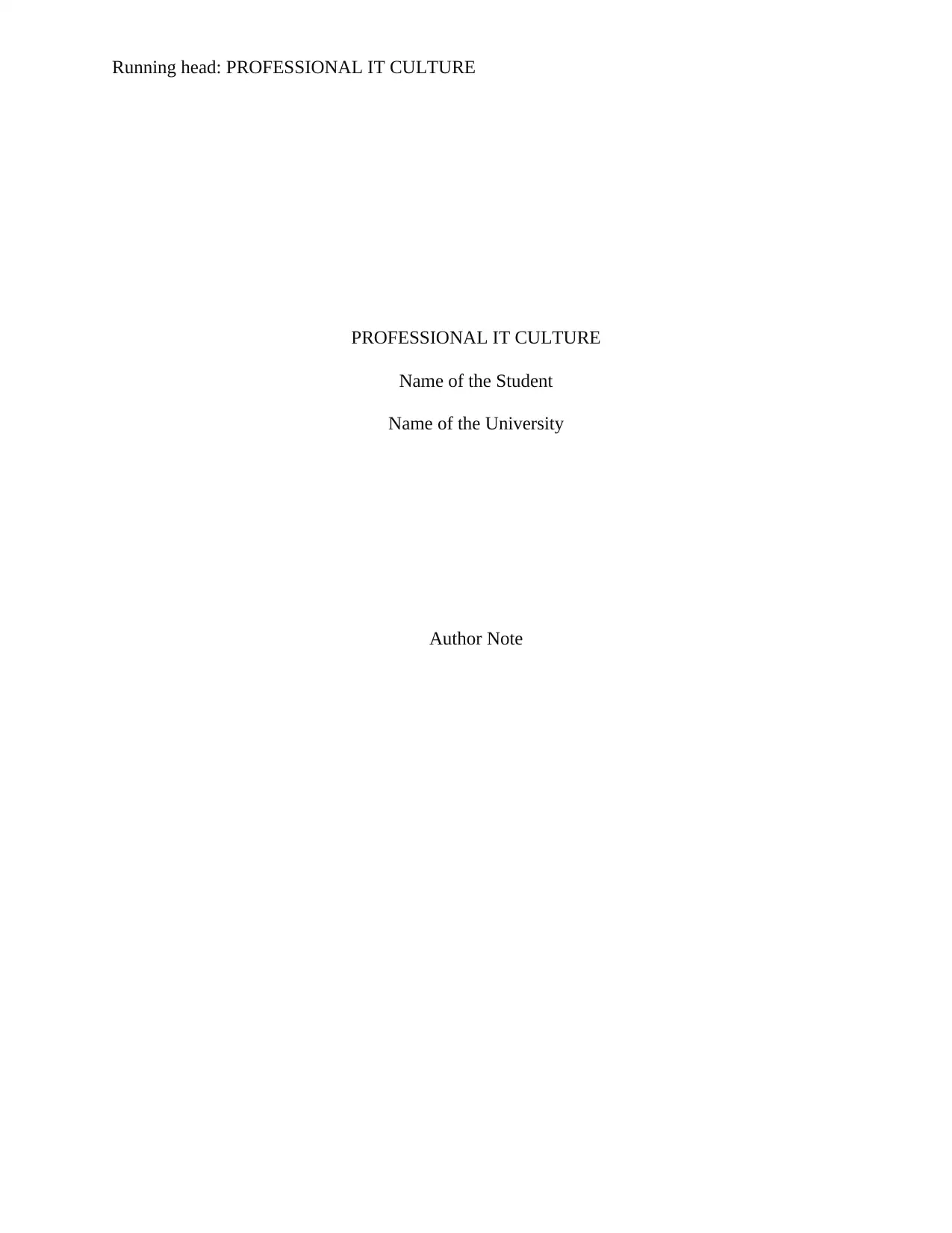
Running head: PROFESSIONAL IT CULTURE
PROFESSIONAL IT CULTURE
Name of the Student
Name of the University
Author Note
PROFESSIONAL IT CULTURE
Name of the Student
Name of the University
Author Note
Paraphrase This Document
Need a fresh take? Get an instant paraphrase of this document with our AI Paraphraser
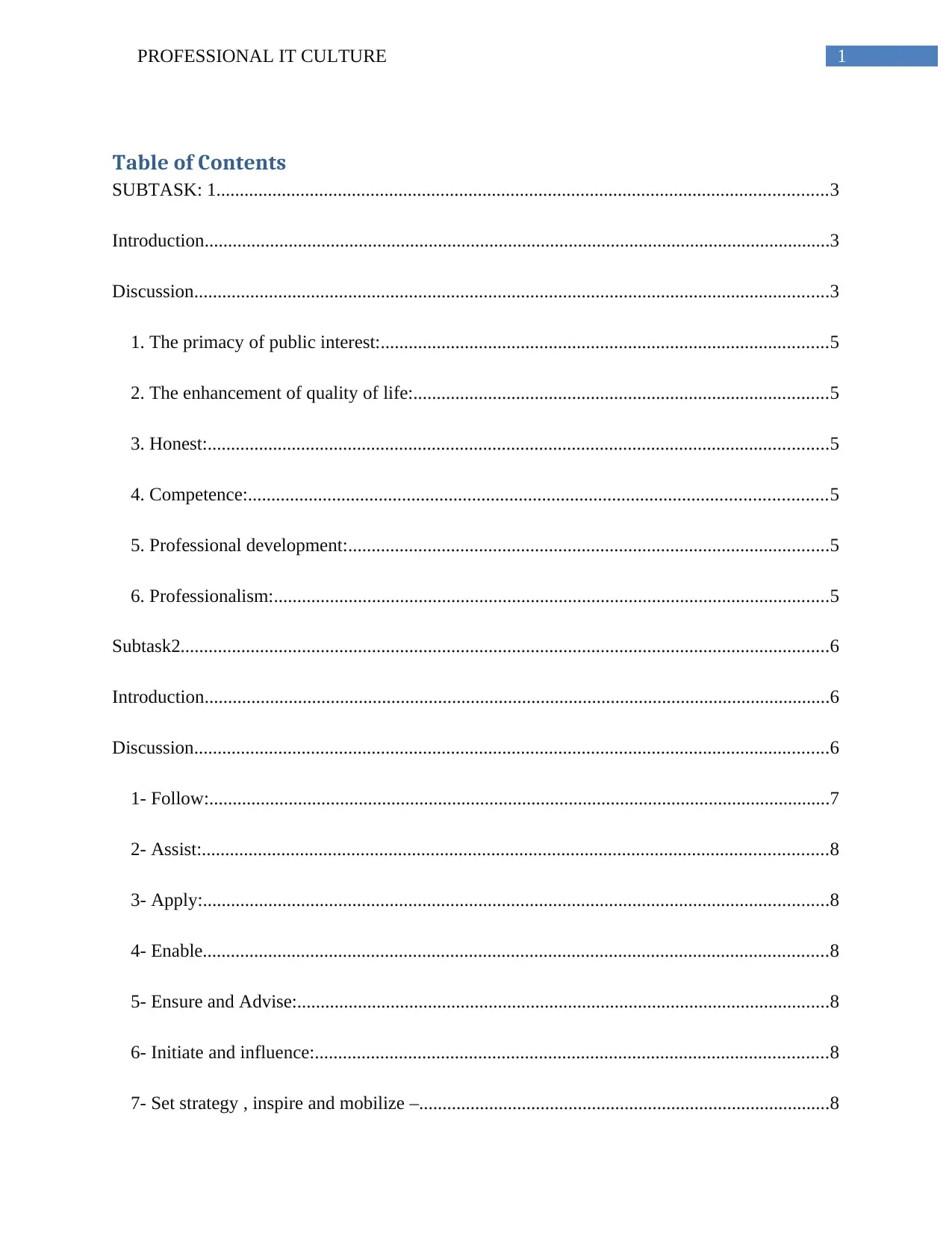
1PROFESSIONAL IT CULTURE
Table of Contents
SUBTASK: 1...................................................................................................................................3
Introduction......................................................................................................................................3
Discussion........................................................................................................................................3
1. The primacy of public interest:................................................................................................5
2. The enhancement of quality of life:.........................................................................................5
3. Honest:.....................................................................................................................................5
4. Competence:............................................................................................................................5
5. Professional development:.......................................................................................................5
6. Professionalism:.......................................................................................................................5
Subtask2...........................................................................................................................................6
Introduction......................................................................................................................................6
Discussion........................................................................................................................................6
1- Follow:.....................................................................................................................................7
2- Assist:......................................................................................................................................8
3- Apply:......................................................................................................................................8
4- Enable......................................................................................................................................8
5- Ensure and Advise:..................................................................................................................8
6- Initiate and influence:..............................................................................................................8
7- Set strategy , inspire and mobilize –........................................................................................8
Table of Contents
SUBTASK: 1...................................................................................................................................3
Introduction......................................................................................................................................3
Discussion........................................................................................................................................3
1. The primacy of public interest:................................................................................................5
2. The enhancement of quality of life:.........................................................................................5
3. Honest:.....................................................................................................................................5
4. Competence:............................................................................................................................5
5. Professional development:.......................................................................................................5
6. Professionalism:.......................................................................................................................5
Subtask2...........................................................................................................................................6
Introduction......................................................................................................................................6
Discussion........................................................................................................................................6
1- Follow:.....................................................................................................................................7
2- Assist:......................................................................................................................................8
3- Apply:......................................................................................................................................8
4- Enable......................................................................................................................................8
5- Ensure and Advise:..................................................................................................................8
6- Initiate and influence:..............................................................................................................8
7- Set strategy , inspire and mobilize –........................................................................................8
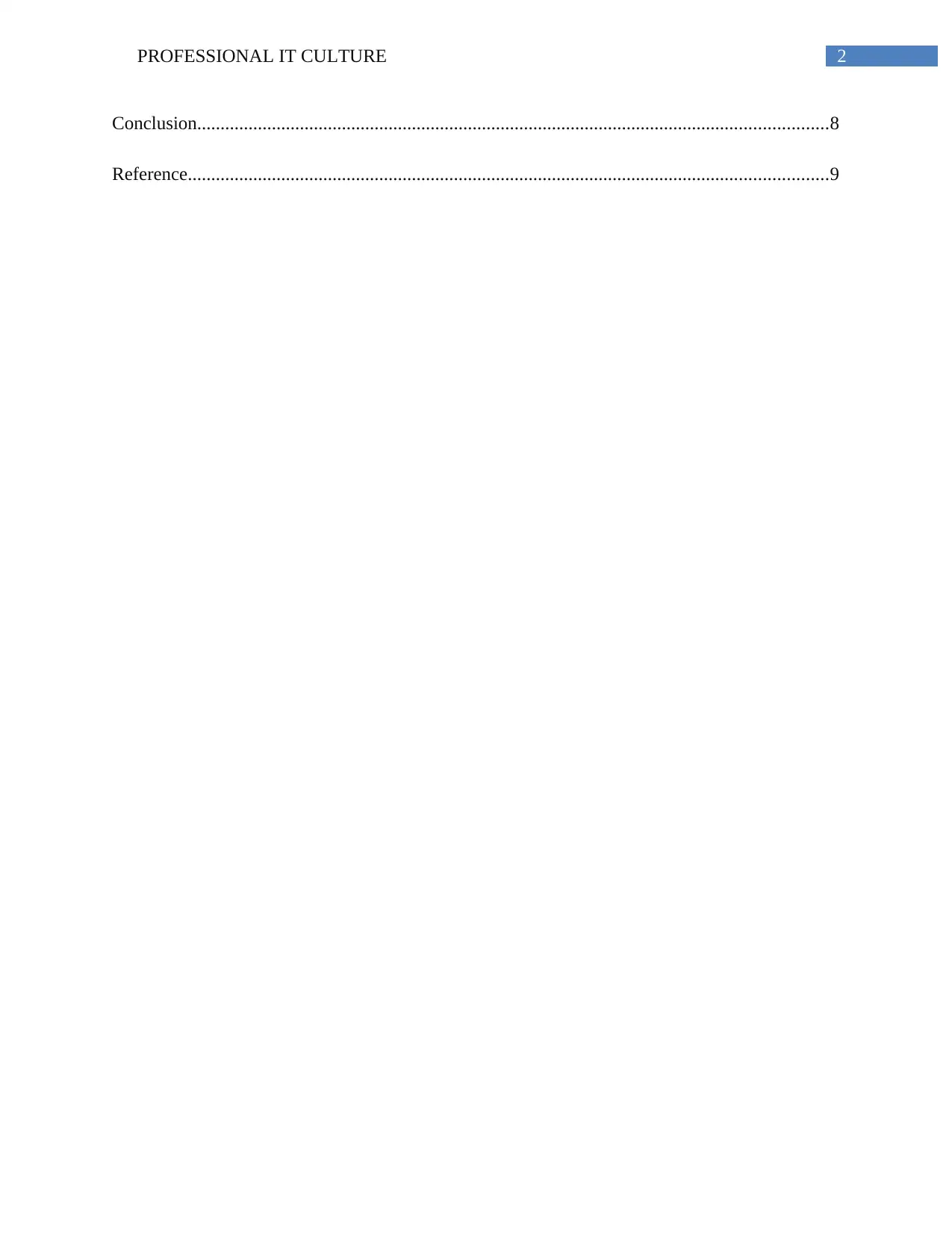
2PROFESSIONAL IT CULTURE
Conclusion.......................................................................................................................................8
Reference.........................................................................................................................................9
Conclusion.......................................................................................................................................8
Reference.........................................................................................................................................9
⊘ This is a preview!⊘
Do you want full access?
Subscribe today to unlock all pages.

Trusted by 1+ million students worldwide
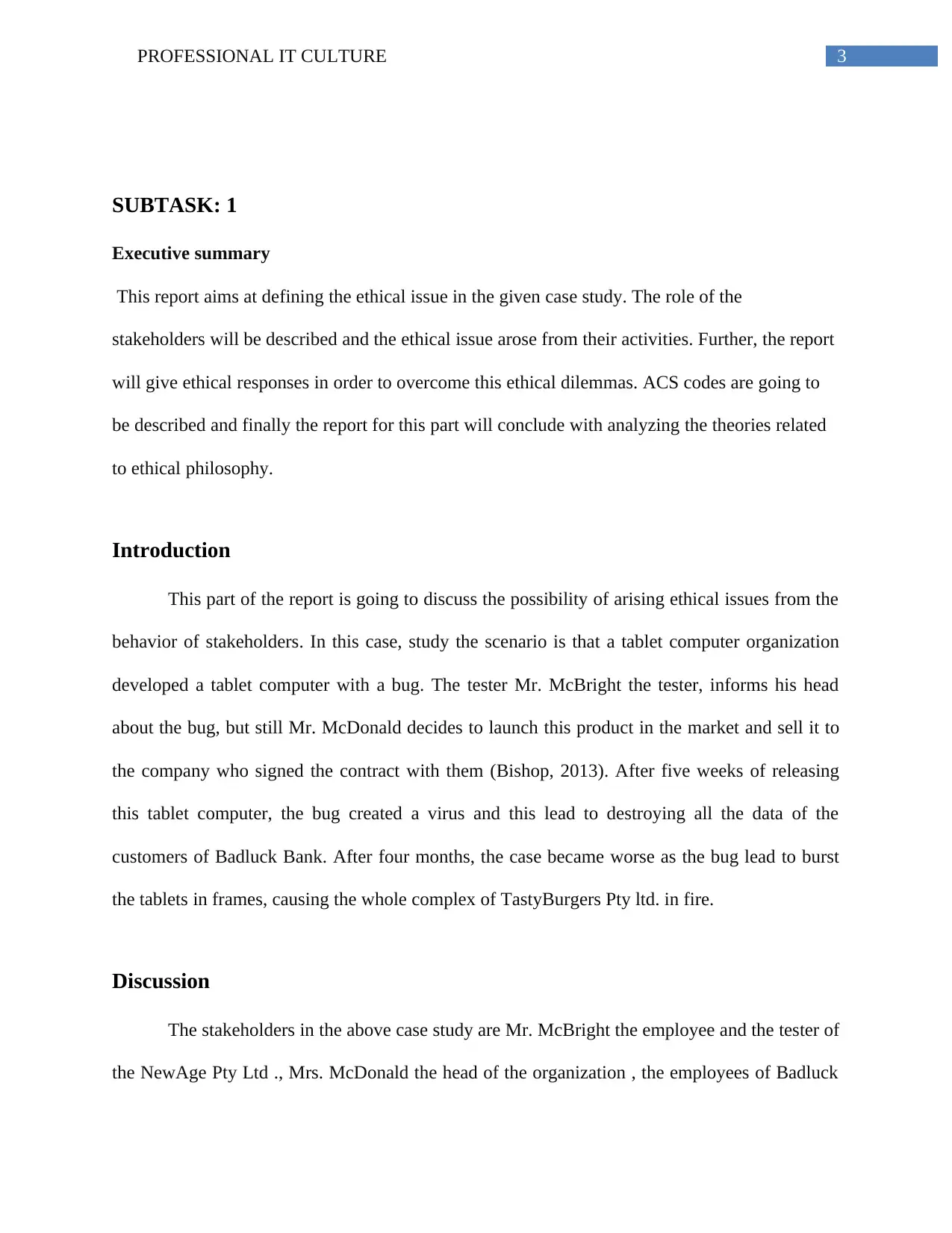
3PROFESSIONAL IT CULTURE
SUBTASK: 1
Executive summary
This report aims at defining the ethical issue in the given case study. The role of the
stakeholders will be described and the ethical issue arose from their activities. Further, the report
will give ethical responses in order to overcome this ethical dilemmas. ACS codes are going to
be described and finally the report for this part will conclude with analyzing the theories related
to ethical philosophy.
Introduction
This part of the report is going to discuss the possibility of arising ethical issues from the
behavior of stakeholders. In this case, study the scenario is that a tablet computer organization
developed a tablet computer with a bug. The tester Mr. McBright the tester, informs his head
about the bug, but still Mr. McDonald decides to launch this product in the market and sell it to
the company who signed the contract with them (Bishop, 2013). After five weeks of releasing
this tablet computer, the bug created a virus and this lead to destroying all the data of the
customers of Badluck Bank. After four months, the case became worse as the bug lead to burst
the tablets in frames, causing the whole complex of TastyBurgers Pty ltd. in fire.
Discussion
The stakeholders in the above case study are Mr. McBright the employee and the tester of
the NewAge Pty Ltd ., Mrs. McDonald the head of the organization , the employees of Badluck
SUBTASK: 1
Executive summary
This report aims at defining the ethical issue in the given case study. The role of the
stakeholders will be described and the ethical issue arose from their activities. Further, the report
will give ethical responses in order to overcome this ethical dilemmas. ACS codes are going to
be described and finally the report for this part will conclude with analyzing the theories related
to ethical philosophy.
Introduction
This part of the report is going to discuss the possibility of arising ethical issues from the
behavior of stakeholders. In this case, study the scenario is that a tablet computer organization
developed a tablet computer with a bug. The tester Mr. McBright the tester, informs his head
about the bug, but still Mr. McDonald decides to launch this product in the market and sell it to
the company who signed the contract with them (Bishop, 2013). After five weeks of releasing
this tablet computer, the bug created a virus and this lead to destroying all the data of the
customers of Badluck Bank. After four months, the case became worse as the bug lead to burst
the tablets in frames, causing the whole complex of TastyBurgers Pty ltd. in fire.
Discussion
The stakeholders in the above case study are Mr. McBright the employee and the tester of
the NewAge Pty Ltd ., Mrs. McDonald the head of the organization , the employees of Badluck
Paraphrase This Document
Need a fresh take? Get an instant paraphrase of this document with our AI Paraphraser
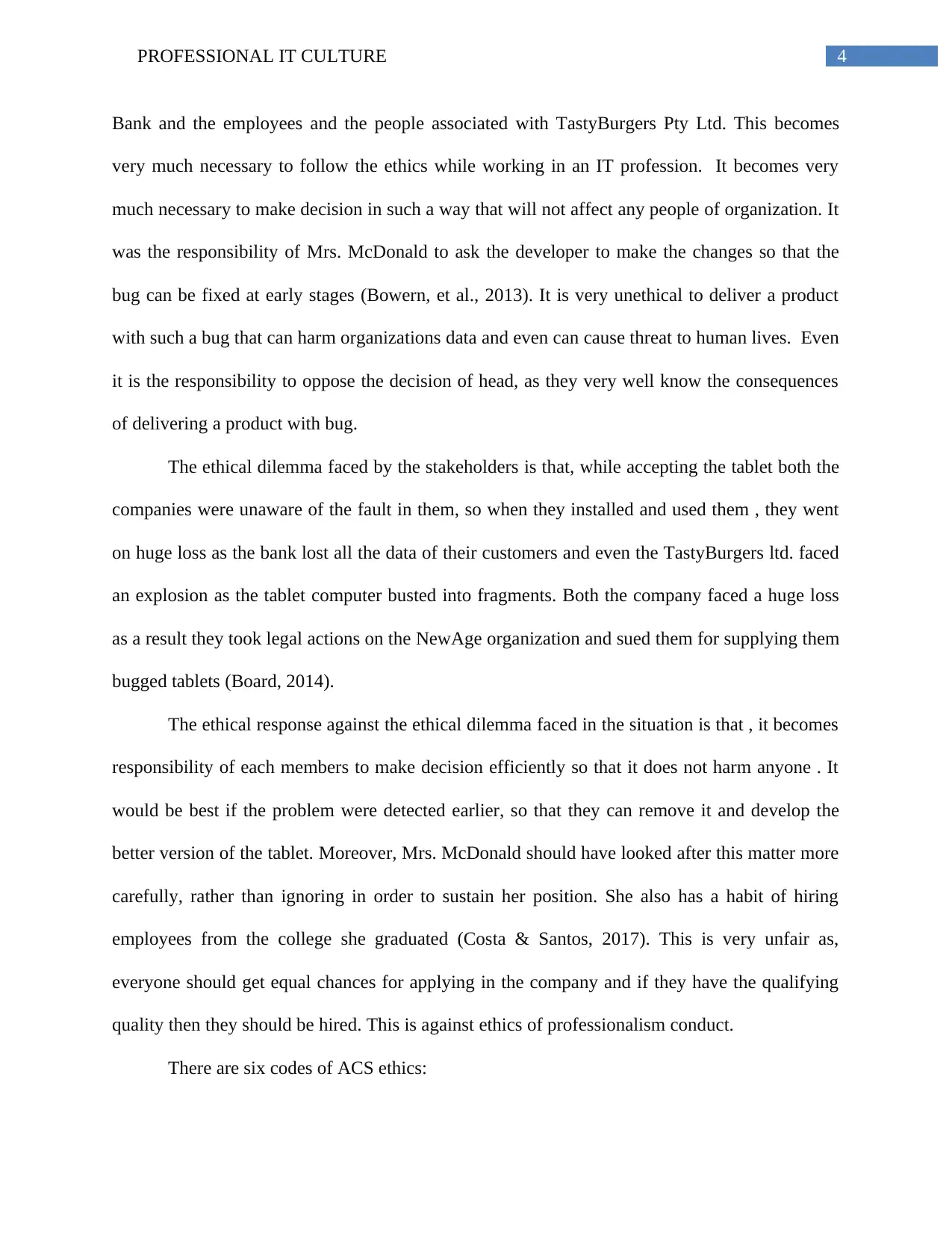
4PROFESSIONAL IT CULTURE
Bank and the employees and the people associated with TastyBurgers Pty Ltd. This becomes
very much necessary to follow the ethics while working in an IT profession. It becomes very
much necessary to make decision in such a way that will not affect any people of organization. It
was the responsibility of Mrs. McDonald to ask the developer to make the changes so that the
bug can be fixed at early stages (Bowern, et al., 2013). It is very unethical to deliver a product
with such a bug that can harm organizations data and even can cause threat to human lives. Even
it is the responsibility to oppose the decision of head, as they very well know the consequences
of delivering a product with bug.
The ethical dilemma faced by the stakeholders is that, while accepting the tablet both the
companies were unaware of the fault in them, so when they installed and used them , they went
on huge loss as the bank lost all the data of their customers and even the TastyBurgers ltd. faced
an explosion as the tablet computer busted into fragments. Both the company faced a huge loss
as a result they took legal actions on the NewAge organization and sued them for supplying them
bugged tablets (Board, 2014).
The ethical response against the ethical dilemma faced in the situation is that , it becomes
responsibility of each members to make decision efficiently so that it does not harm anyone . It
would be best if the problem were detected earlier, so that they can remove it and develop the
better version of the tablet. Moreover, Mrs. McDonald should have looked after this matter more
carefully, rather than ignoring in order to sustain her position. She also has a habit of hiring
employees from the college she graduated (Costa & Santos, 2017). This is very unfair as,
everyone should get equal chances for applying in the company and if they have the qualifying
quality then they should be hired. This is against ethics of professionalism conduct.
There are six codes of ACS ethics:
Bank and the employees and the people associated with TastyBurgers Pty Ltd. This becomes
very much necessary to follow the ethics while working in an IT profession. It becomes very
much necessary to make decision in such a way that will not affect any people of organization. It
was the responsibility of Mrs. McDonald to ask the developer to make the changes so that the
bug can be fixed at early stages (Bowern, et al., 2013). It is very unethical to deliver a product
with such a bug that can harm organizations data and even can cause threat to human lives. Even
it is the responsibility to oppose the decision of head, as they very well know the consequences
of delivering a product with bug.
The ethical dilemma faced by the stakeholders is that, while accepting the tablet both the
companies were unaware of the fault in them, so when they installed and used them , they went
on huge loss as the bank lost all the data of their customers and even the TastyBurgers ltd. faced
an explosion as the tablet computer busted into fragments. Both the company faced a huge loss
as a result they took legal actions on the NewAge organization and sued them for supplying them
bugged tablets (Board, 2014).
The ethical response against the ethical dilemma faced in the situation is that , it becomes
responsibility of each members to make decision efficiently so that it does not harm anyone . It
would be best if the problem were detected earlier, so that they can remove it and develop the
better version of the tablet. Moreover, Mrs. McDonald should have looked after this matter more
carefully, rather than ignoring in order to sustain her position. She also has a habit of hiring
employees from the college she graduated (Costa & Santos, 2017). This is very unfair as,
everyone should get equal chances for applying in the company and if they have the qualifying
quality then they should be hired. This is against ethics of professionalism conduct.
There are six codes of ACS ethics:
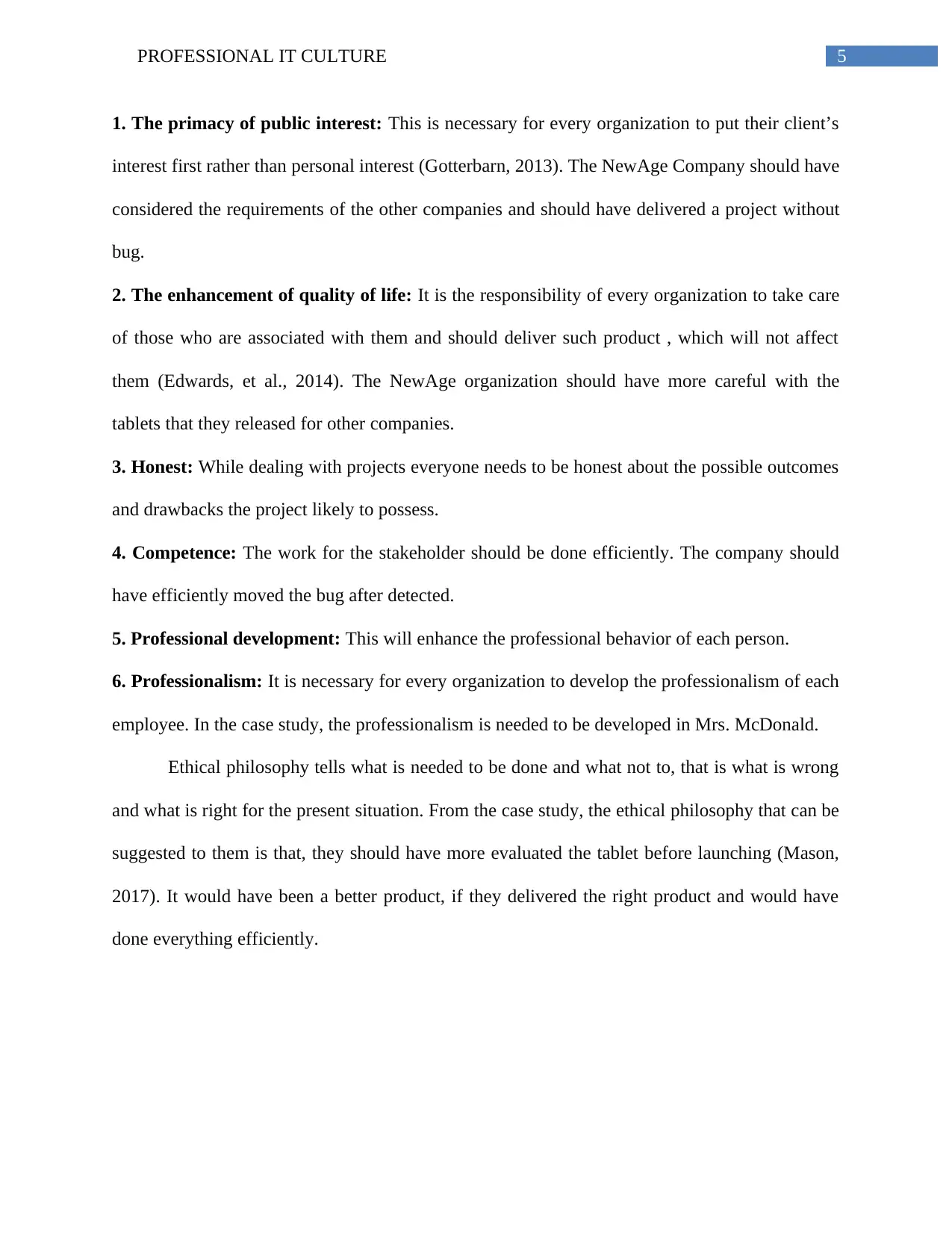
5PROFESSIONAL IT CULTURE
1. The primacy of public interest: This is necessary for every organization to put their client’s
interest first rather than personal interest (Gotterbarn, 2013). The NewAge Company should have
considered the requirements of the other companies and should have delivered a project without
bug.
2. The enhancement of quality of life: It is the responsibility of every organization to take care
of those who are associated with them and should deliver such product , which will not affect
them (Edwards, et al., 2014). The NewAge organization should have more careful with the
tablets that they released for other companies.
3. Honest: While dealing with projects everyone needs to be honest about the possible outcomes
and drawbacks the project likely to possess.
4. Competence: The work for the stakeholder should be done efficiently. The company should
have efficiently moved the bug after detected.
5. Professional development: This will enhance the professional behavior of each person.
6. Professionalism: It is necessary for every organization to develop the professionalism of each
employee. In the case study, the professionalism is needed to be developed in Mrs. McDonald.
Ethical philosophy tells what is needed to be done and what not to, that is what is wrong
and what is right for the present situation. From the case study, the ethical philosophy that can be
suggested to them is that, they should have more evaluated the tablet before launching (Mason,
2017). It would have been a better product, if they delivered the right product and would have
done everything efficiently.
1. The primacy of public interest: This is necessary for every organization to put their client’s
interest first rather than personal interest (Gotterbarn, 2013). The NewAge Company should have
considered the requirements of the other companies and should have delivered a project without
bug.
2. The enhancement of quality of life: It is the responsibility of every organization to take care
of those who are associated with them and should deliver such product , which will not affect
them (Edwards, et al., 2014). The NewAge organization should have more careful with the
tablets that they released for other companies.
3. Honest: While dealing with projects everyone needs to be honest about the possible outcomes
and drawbacks the project likely to possess.
4. Competence: The work for the stakeholder should be done efficiently. The company should
have efficiently moved the bug after detected.
5. Professional development: This will enhance the professional behavior of each person.
6. Professionalism: It is necessary for every organization to develop the professionalism of each
employee. In the case study, the professionalism is needed to be developed in Mrs. McDonald.
Ethical philosophy tells what is needed to be done and what not to, that is what is wrong
and what is right for the present situation. From the case study, the ethical philosophy that can be
suggested to them is that, they should have more evaluated the tablet before launching (Mason,
2017). It would have been a better product, if they delivered the right product and would have
done everything efficiently.
⊘ This is a preview!⊘
Do you want full access?
Subscribe today to unlock all pages.

Trusted by 1+ million students worldwide
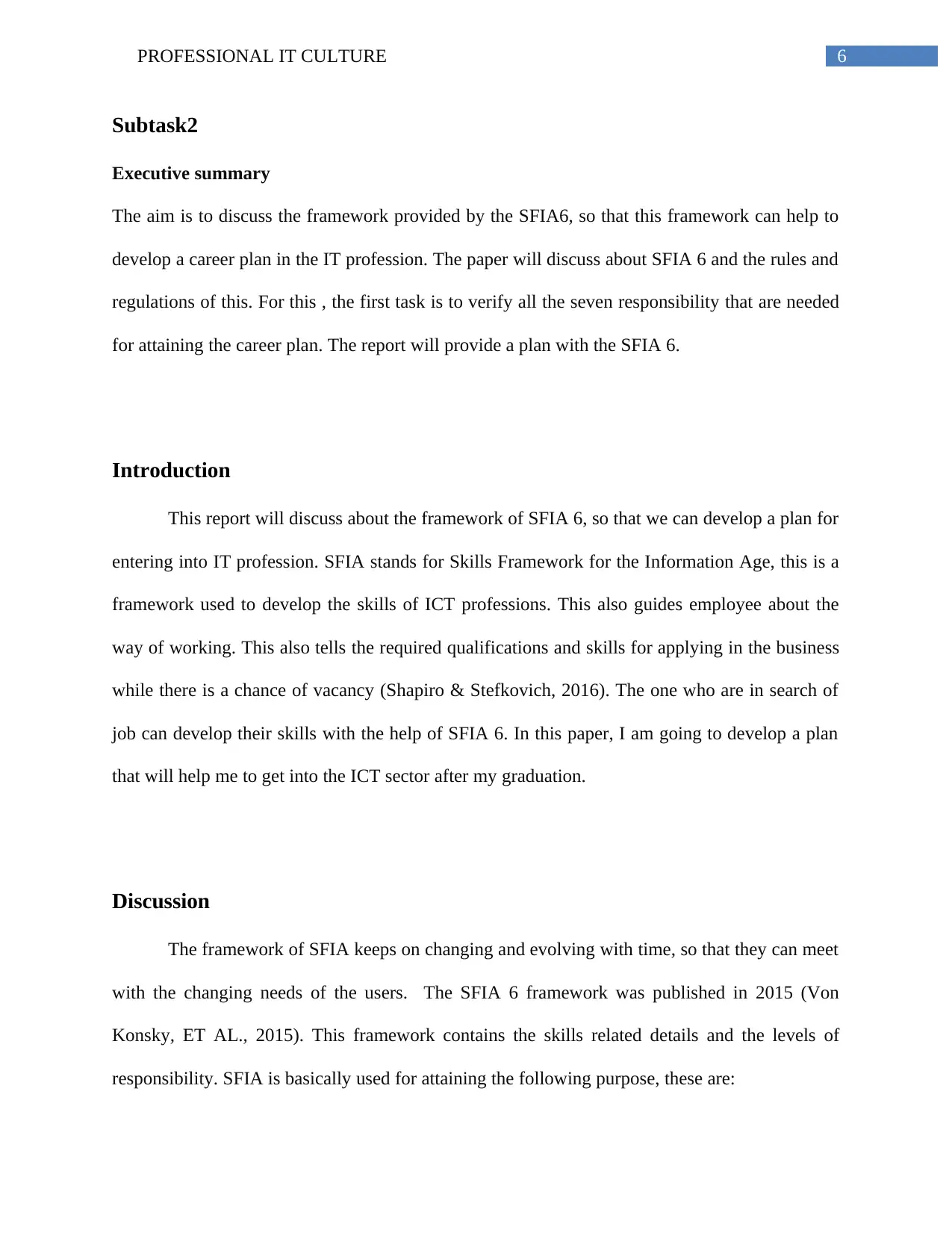
6PROFESSIONAL IT CULTURE
Subtask2
Executive summary
The aim is to discuss the framework provided by the SFIA6, so that this framework can help to
develop a career plan in the IT profession. The paper will discuss about SFIA 6 and the rules and
regulations of this. For this , the first task is to verify all the seven responsibility that are needed
for attaining the career plan. The report will provide a plan with the SFIA 6.
Introduction
This report will discuss about the framework of SFIA 6, so that we can develop a plan for
entering into IT profession. SFIA stands for Skills Framework for the Information Age, this is a
framework used to develop the skills of ICT professions. This also guides employee about the
way of working. This also tells the required qualifications and skills for applying in the business
while there is a chance of vacancy (Shapiro & Stefkovich, 2016). The one who are in search of
job can develop their skills with the help of SFIA 6. In this paper, I am going to develop a plan
that will help me to get into the ICT sector after my graduation.
Discussion
The framework of SFIA keeps on changing and evolving with time, so that they can meet
with the changing needs of the users. The SFIA 6 framework was published in 2015 (Von
Konsky, ET AL., 2015). This framework contains the skills related details and the levels of
responsibility. SFIA is basically used for attaining the following purpose, these are:
Subtask2
Executive summary
The aim is to discuss the framework provided by the SFIA6, so that this framework can help to
develop a career plan in the IT profession. The paper will discuss about SFIA 6 and the rules and
regulations of this. For this , the first task is to verify all the seven responsibility that are needed
for attaining the career plan. The report will provide a plan with the SFIA 6.
Introduction
This report will discuss about the framework of SFIA 6, so that we can develop a plan for
entering into IT profession. SFIA stands for Skills Framework for the Information Age, this is a
framework used to develop the skills of ICT professions. This also guides employee about the
way of working. This also tells the required qualifications and skills for applying in the business
while there is a chance of vacancy (Shapiro & Stefkovich, 2016). The one who are in search of
job can develop their skills with the help of SFIA 6. In this paper, I am going to develop a plan
that will help me to get into the ICT sector after my graduation.
Discussion
The framework of SFIA keeps on changing and evolving with time, so that they can meet
with the changing needs of the users. The SFIA 6 framework was published in 2015 (Von
Konsky, ET AL., 2015). This framework contains the skills related details and the levels of
responsibility. SFIA is basically used for attaining the following purpose, these are:
Paraphrase This Document
Need a fresh take? Get an instant paraphrase of this document with our AI Paraphraser
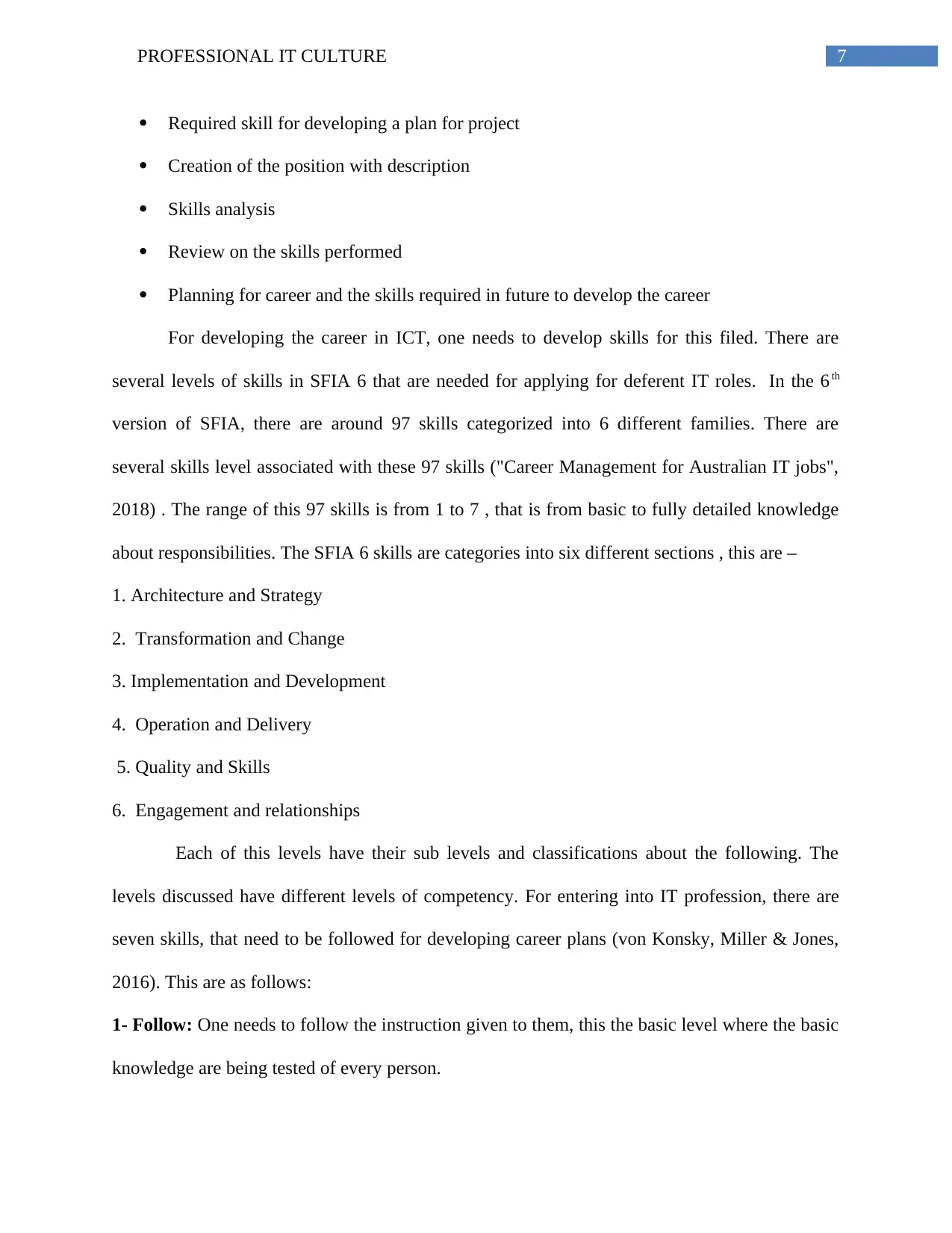
7PROFESSIONAL IT CULTURE
Required skill for developing a plan for project
Creation of the position with description
Skills analysis
Review on the skills performed
Planning for career and the skills required in future to develop the career
For developing the career in ICT, one needs to develop skills for this filed. There are
several levels of skills in SFIA 6 that are needed for applying for deferent IT roles. In the 6 th
version of SFIA, there are around 97 skills categorized into 6 different families. There are
several skills level associated with these 97 skills ("Career Management for Australian IT jobs",
2018) . The range of this 97 skills is from 1 to 7 , that is from basic to fully detailed knowledge
about responsibilities. The SFIA 6 skills are categories into six different sections , this are –
1. Architecture and Strategy
2. Transformation and Change
3. Implementation and Development
4. Operation and Delivery
5. Quality and Skills
6. Engagement and relationships
Each of this levels have their sub levels and classifications about the following. The
levels discussed have different levels of competency. For entering into IT profession, there are
seven skills, that need to be followed for developing career plans (von Konsky, Miller & Jones,
2016). This are as follows:
1- Follow: One needs to follow the instruction given to them, this the basic level where the basic
knowledge are being tested of every person.
Required skill for developing a plan for project
Creation of the position with description
Skills analysis
Review on the skills performed
Planning for career and the skills required in future to develop the career
For developing the career in ICT, one needs to develop skills for this filed. There are
several levels of skills in SFIA 6 that are needed for applying for deferent IT roles. In the 6 th
version of SFIA, there are around 97 skills categorized into 6 different families. There are
several skills level associated with these 97 skills ("Career Management for Australian IT jobs",
2018) . The range of this 97 skills is from 1 to 7 , that is from basic to fully detailed knowledge
about responsibilities. The SFIA 6 skills are categories into six different sections , this are –
1. Architecture and Strategy
2. Transformation and Change
3. Implementation and Development
4. Operation and Delivery
5. Quality and Skills
6. Engagement and relationships
Each of this levels have their sub levels and classifications about the following. The
levels discussed have different levels of competency. For entering into IT profession, there are
seven skills, that need to be followed for developing career plans (von Konsky, Miller & Jones,
2016). This are as follows:
1- Follow: One needs to follow the instruction given to them, this the basic level where the basic
knowledge are being tested of every person.
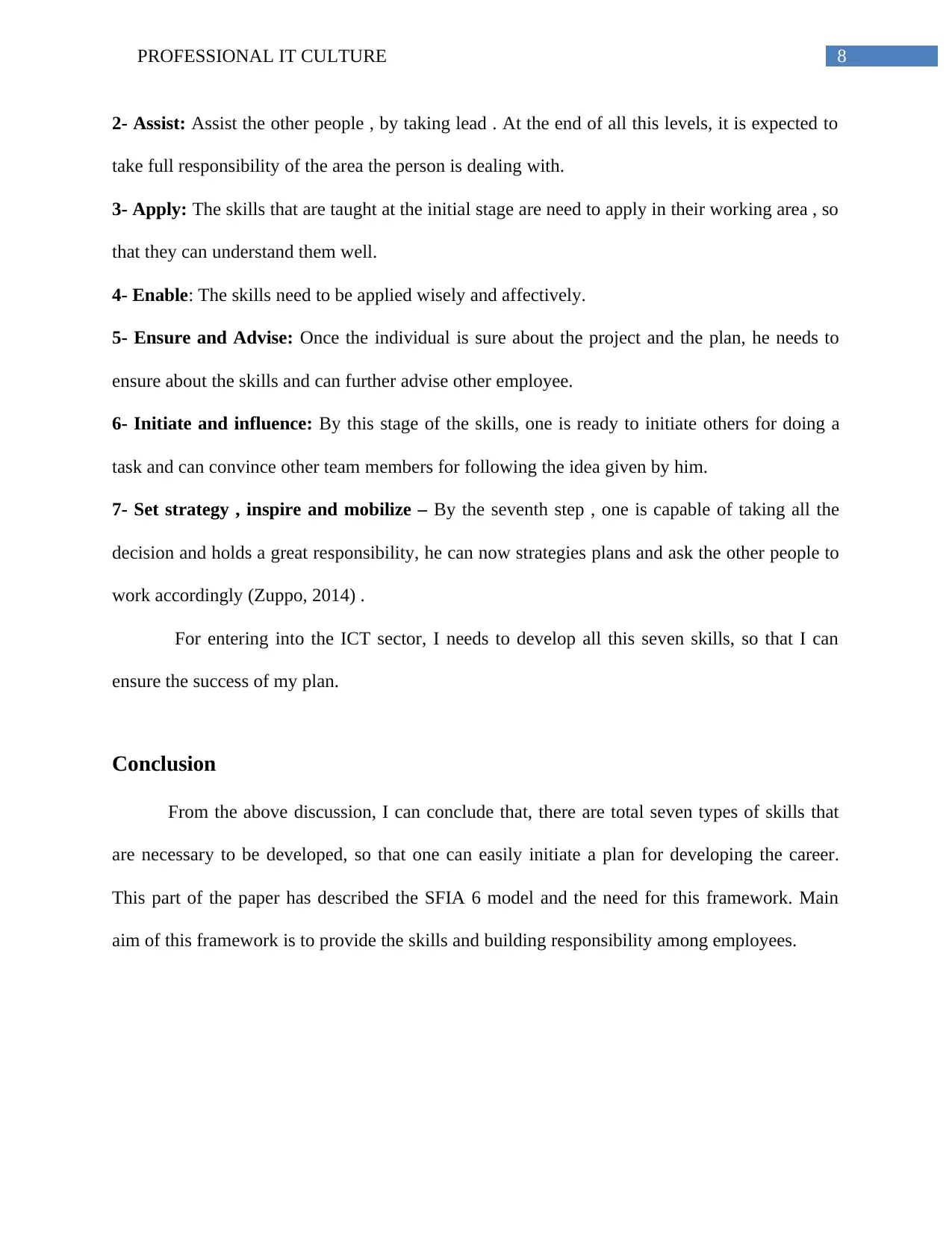
8PROFESSIONAL IT CULTURE
2- Assist: Assist the other people , by taking lead . At the end of all this levels, it is expected to
take full responsibility of the area the person is dealing with.
3- Apply: The skills that are taught at the initial stage are need to apply in their working area , so
that they can understand them well.
4- Enable: The skills need to be applied wisely and affectively.
5- Ensure and Advise: Once the individual is sure about the project and the plan, he needs to
ensure about the skills and can further advise other employee.
6- Initiate and influence: By this stage of the skills, one is ready to initiate others for doing a
task and can convince other team members for following the idea given by him.
7- Set strategy , inspire and mobilize – By the seventh step , one is capable of taking all the
decision and holds a great responsibility, he can now strategies plans and ask the other people to
work accordingly (Zuppo, 2014) .
For entering into the ICT sector, I needs to develop all this seven skills, so that I can
ensure the success of my plan.
Conclusion
From the above discussion, I can conclude that, there are total seven types of skills that
are necessary to be developed, so that one can easily initiate a plan for developing the career.
This part of the paper has described the SFIA 6 model and the need for this framework. Main
aim of this framework is to provide the skills and building responsibility among employees.
2- Assist: Assist the other people , by taking lead . At the end of all this levels, it is expected to
take full responsibility of the area the person is dealing with.
3- Apply: The skills that are taught at the initial stage are need to apply in their working area , so
that they can understand them well.
4- Enable: The skills need to be applied wisely and affectively.
5- Ensure and Advise: Once the individual is sure about the project and the plan, he needs to
ensure about the skills and can further advise other employee.
6- Initiate and influence: By this stage of the skills, one is ready to initiate others for doing a
task and can convince other team members for following the idea given by him.
7- Set strategy , inspire and mobilize – By the seventh step , one is capable of taking all the
decision and holds a great responsibility, he can now strategies plans and ask the other people to
work accordingly (Zuppo, 2014) .
For entering into the ICT sector, I needs to develop all this seven skills, so that I can
ensure the success of my plan.
Conclusion
From the above discussion, I can conclude that, there are total seven types of skills that
are necessary to be developed, so that one can easily initiate a plan for developing the career.
This part of the paper has described the SFIA 6 model and the need for this framework. Main
aim of this framework is to provide the skills and building responsibility among employees.
⊘ This is a preview!⊘
Do you want full access?
Subscribe today to unlock all pages.

Trusted by 1+ million students worldwide
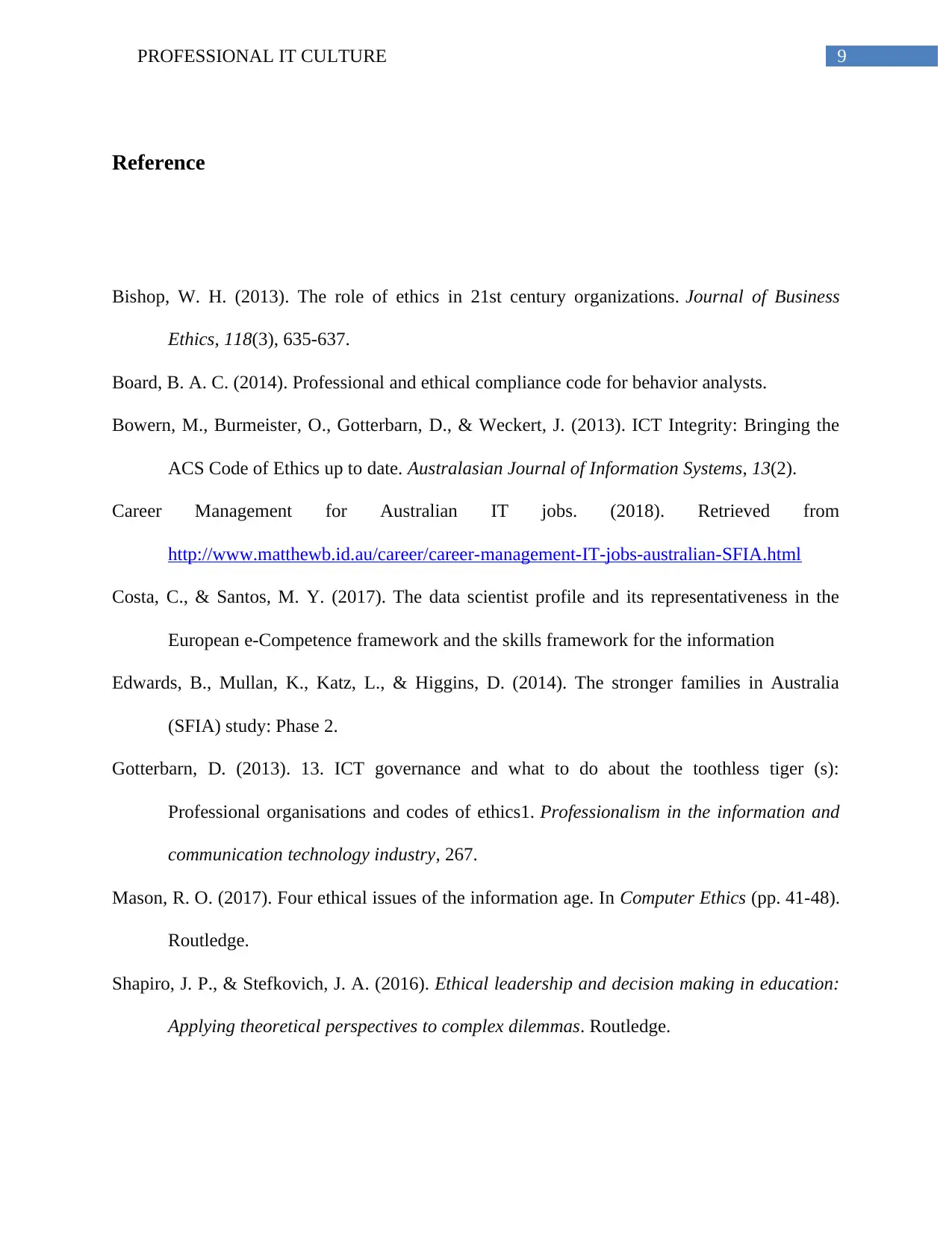
9PROFESSIONAL IT CULTURE
Reference
Bishop, W. H. (2013). The role of ethics in 21st century organizations. Journal of Business
Ethics, 118(3), 635-637.
Board, B. A. C. (2014). Professional and ethical compliance code for behavior analysts.
Bowern, M., Burmeister, O., Gotterbarn, D., & Weckert, J. (2013). ICT Integrity: Bringing the
ACS Code of Ethics up to date. Australasian Journal of Information Systems, 13(2).
Career Management for Australian IT jobs. (2018). Retrieved from
http://www.matthewb.id.au/career/career-management-IT-jobs-australian-SFIA.html
Costa, C., & Santos, M. Y. (2017). The data scientist profile and its representativeness in the
European e-Competence framework and the skills framework for the information
Edwards, B., Mullan, K., Katz, L., & Higgins, D. (2014). The stronger families in Australia
(SFIA) study: Phase 2.
Gotterbarn, D. (2013). 13. ICT governance and what to do about the toothless tiger (s):
Professional organisations and codes of ethics1. Professionalism in the information and
communication technology industry, 267.
Mason, R. O. (2017). Four ethical issues of the information age. In Computer Ethics (pp. 41-48).
Routledge.
Shapiro, J. P., & Stefkovich, J. A. (2016). Ethical leadership and decision making in education:
Applying theoretical perspectives to complex dilemmas. Routledge.
Reference
Bishop, W. H. (2013). The role of ethics in 21st century organizations. Journal of Business
Ethics, 118(3), 635-637.
Board, B. A. C. (2014). Professional and ethical compliance code for behavior analysts.
Bowern, M., Burmeister, O., Gotterbarn, D., & Weckert, J. (2013). ICT Integrity: Bringing the
ACS Code of Ethics up to date. Australasian Journal of Information Systems, 13(2).
Career Management for Australian IT jobs. (2018). Retrieved from
http://www.matthewb.id.au/career/career-management-IT-jobs-australian-SFIA.html
Costa, C., & Santos, M. Y. (2017). The data scientist profile and its representativeness in the
European e-Competence framework and the skills framework for the information
Edwards, B., Mullan, K., Katz, L., & Higgins, D. (2014). The stronger families in Australia
(SFIA) study: Phase 2.
Gotterbarn, D. (2013). 13. ICT governance and what to do about the toothless tiger (s):
Professional organisations and codes of ethics1. Professionalism in the information and
communication technology industry, 267.
Mason, R. O. (2017). Four ethical issues of the information age. In Computer Ethics (pp. 41-48).
Routledge.
Shapiro, J. P., & Stefkovich, J. A. (2016). Ethical leadership and decision making in education:
Applying theoretical perspectives to complex dilemmas. Routledge.
Paraphrase This Document
Need a fresh take? Get an instant paraphrase of this document with our AI Paraphraser
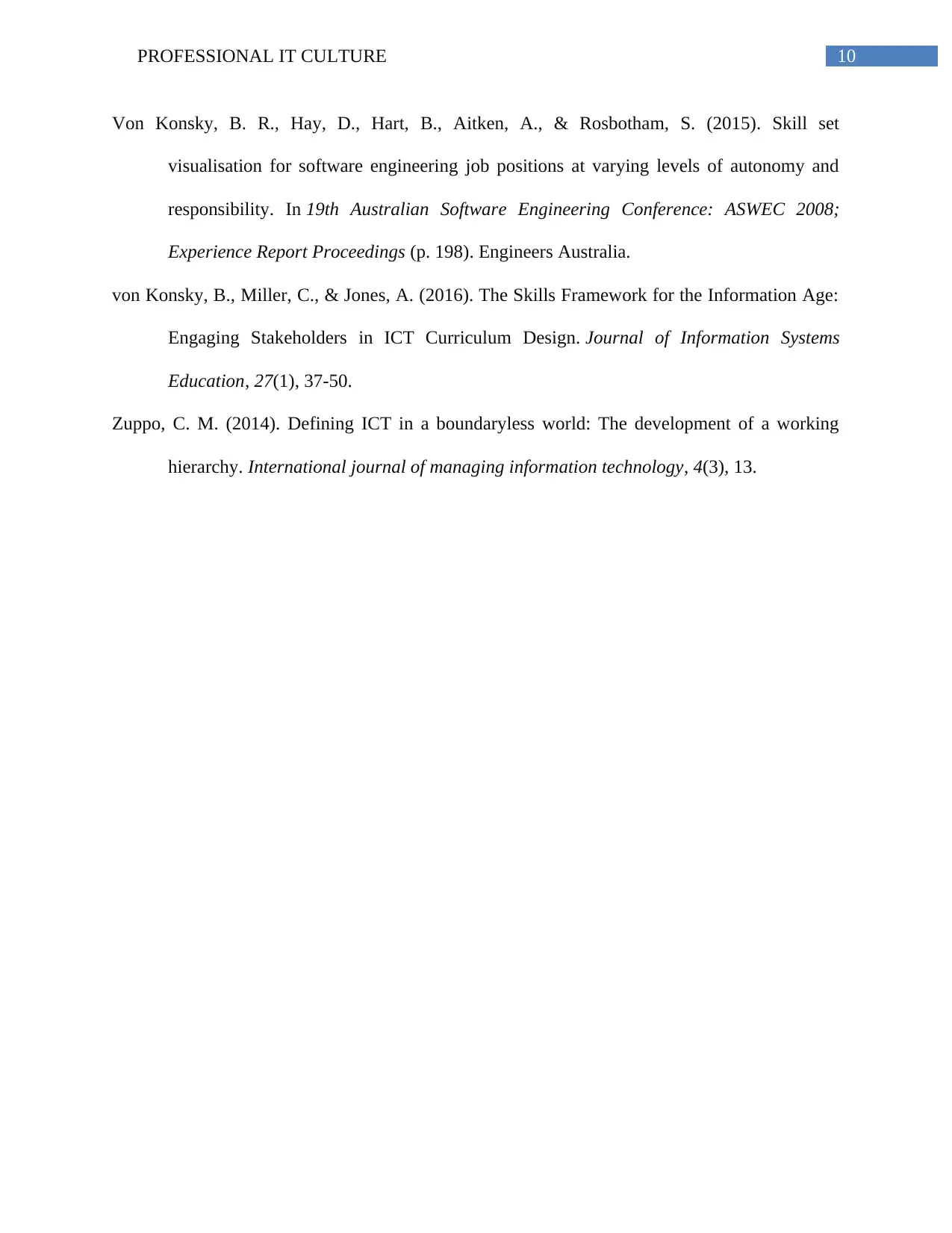
10PROFESSIONAL IT CULTURE
Von Konsky, B. R., Hay, D., Hart, B., Aitken, A., & Rosbotham, S. (2015). Skill set
visualisation for software engineering job positions at varying levels of autonomy and
responsibility. In 19th Australian Software Engineering Conference: ASWEC 2008;
Experience Report Proceedings (p. 198). Engineers Australia.
von Konsky, B., Miller, C., & Jones, A. (2016). The Skills Framework for the Information Age:
Engaging Stakeholders in ICT Curriculum Design. Journal of Information Systems
Education, 27(1), 37-50.
Zuppo, C. M. (2014). Defining ICT in a boundaryless world: The development of a working
hierarchy. International journal of managing information technology, 4(3), 13.
Von Konsky, B. R., Hay, D., Hart, B., Aitken, A., & Rosbotham, S. (2015). Skill set
visualisation for software engineering job positions at varying levels of autonomy and
responsibility. In 19th Australian Software Engineering Conference: ASWEC 2008;
Experience Report Proceedings (p. 198). Engineers Australia.
von Konsky, B., Miller, C., & Jones, A. (2016). The Skills Framework for the Information Age:
Engaging Stakeholders in ICT Curriculum Design. Journal of Information Systems
Education, 27(1), 37-50.
Zuppo, C. M. (2014). Defining ICT in a boundaryless world: The development of a working
hierarchy. International journal of managing information technology, 4(3), 13.
1 out of 11
Related Documents
Your All-in-One AI-Powered Toolkit for Academic Success.
+13062052269
info@desklib.com
Available 24*7 on WhatsApp / Email
![[object Object]](/_next/static/media/star-bottom.7253800d.svg)
Unlock your academic potential
Copyright © 2020–2025 A2Z Services. All Rights Reserved. Developed and managed by ZUCOL.




